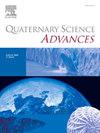伊比利亚北部Cal Guardiola早更新世晚期大马鹿标本的生物年代学和古生物地理学意义
IF 2.2
Q2 GEOGRAPHY, PHYSICAL
引用次数: 0
摘要
欧洲上新世-更新世出现了似大马鹿属的不同种。本文描述了来自伊比利亚半岛东北部Cal Guardiola剖面的中型cervid样本。它与欧洲早更新世晚期不同地点的伪麻(pseudoama vallonnetensis)记录有显著的相似性,从而证实了该分类群在这一时期的动物群关联中的丰度。在这里,我们回顾了P. vallonnetensis在欧洲的时空分布,并在更广泛的框架内,分析了整个更新世期间大马鹿物种的演代,分析了体型的变化及其与古环境条件之间的可能关系。本文章由计算机程序翻译,如有差异,请以英文原文为准。
Biochronological and paleobiogeographic implications of the Dama-like deer sample from the latest Early Pleistocene of Cal Guardiola (NE Iberia)
Different species of Dama-like deer usually included in the genus Pseudodama, occurred in the European Plio-Pleistocene. In this paper, the medium-sized cervid sample from the Cal Guardiola Section (NE Iberian Peninsula) is described. It exhibits notable similarities with other records referred to Pseudodama vallonnetensis from various late Early Pleistocene European sites, thus confirming the abundance of this taxon in the faunal associations of this period. Here, we review the spatial and temporal distribution of P. vallonnetensis in Europe and, in a broader framework, also the succession of Dama-like deer species during the entire Pleistocene, analyzing variations in body size and possible relationships between these and palaeoenvironmental conditions.
求助全文
通过发布文献求助,成功后即可免费获取论文全文。
去求助
来源期刊

Quaternary Science Advances
Earth and Planetary Sciences-Earth-Surface Processes
CiteScore
4.00
自引率
13.30%
发文量
16
审稿时长
61 days
 求助内容:
求助内容: 应助结果提醒方式:
应助结果提醒方式:


